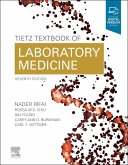- Broschiertes Buch
- Merkliste
- Auf die Merkliste
- Bewerten Bewerten
- Teilen
- Produkt teilen
- Produkterinnerung
- Produkterinnerung
This book contains contributions from international experts in health care, organisational studies and patient safety, as well as resilience engineering.
Andere Kunden interessierten sich auch für
![Biopsy Interpretation: The Frozen Section: Print + eBook with Multimedia Biopsy Interpretation: The Frozen Section: Print + eBook with Multimedia]() Cipriani, Nicole A., MDBiopsy Interpretation: The Frozen Section: Print + eBook with Multimedia195,99 €
Cipriani, Nicole A., MDBiopsy Interpretation: The Frozen Section: Print + eBook with Multimedia195,99 €![Tietz Textbook of Laboratory Medicine Tietz Textbook of Laboratory Medicine]() Nader Rifai (Professor Department of Pathology Harvard Medical SchoTietz Textbook of Laboratory Medicine247,99 €
Nader Rifai (Professor Department of Pathology Harvard Medical SchoTietz Textbook of Laboratory Medicine247,99 €![CPET Made Simple CPET Made Simple]() Tom Lawson (Swansea Bay University Health Board)CPET Made Simple26,99 €
Tom Lawson (Swansea Bay University Health Board)CPET Made Simple26,99 €![The Only Diagnostic Lab Book You'll Ever Need The Only Diagnostic Lab Book You'll Ever Need]() Thaler, Dr. Jonathan, MDThe Only Diagnostic Lab Book You'll Ever Need54,99 €
Thaler, Dr. Jonathan, MDThe Only Diagnostic Lab Book You'll Ever Need54,99 €![Advances in Clinical Cytometry, an Issue of the Clinics in Laboratory Medicine Advances in Clinical Cytometry, an Issue of the Clinics in Laboratory Medicine]() Advances in Clinical Cytometry, an Issue of the Clinics in Laboratory Medicine102,99 €
Advances in Clinical Cytometry, an Issue of the Clinics in Laboratory Medicine102,99 €![Resilient Communities of Central Eurasia Resilient Communities of Central Eurasia]() Resilient Communities of Central Eurasia176,99 €
Resilient Communities of Central Eurasia176,99 €![Resilient Building Retrofits Resilient Building Retrofits]() Resilient Building Retrofits61,99 €
Resilient Building Retrofits61,99 €-
-
-
This book contains contributions from international experts in health care, organisational studies and patient safety, as well as resilience engineering.
Hinweis: Dieser Artikel kann nur an eine deutsche Lieferadresse ausgeliefert werden.
Hinweis: Dieser Artikel kann nur an eine deutsche Lieferadresse ausgeliefert werden.
Produktdetails
- Produktdetails
- Ashgate Studies in Resilience Engineering
- Verlag: Taylor & Francis Ltd
- Seitenzahl: 298
- Erscheinungstermin: 28. August 2015
- Englisch
- Abmessung: 234mm x 156mm x 16mm
- Gewicht: 560g
- ISBN-13: 9781472469199
- ISBN-10: 1472469194
- Artikelnr.: 43492779
- Herstellerkennzeichnung
- Libri GmbH
- Europaallee 1
- 36244 Bad Hersfeld
- gpsr@libri.de
- Ashgate Studies in Resilience Engineering
- Verlag: Taylor & Francis Ltd
- Seitenzahl: 298
- Erscheinungstermin: 28. August 2015
- Englisch
- Abmessung: 234mm x 156mm x 16mm
- Gewicht: 560g
- ISBN-13: 9781472469199
- ISBN-10: 1472469194
- Artikelnr.: 43492779
- Herstellerkennzeichnung
- Libri GmbH
- Europaallee 1
- 36244 Bad Hersfeld
- gpsr@libri.de
Erik Hollnagel (Ph.D., psychology) is Professor at the University of Southern Denmark, Chief Consultant at the Centre for Quality Improvement, Region of Southern Denmark, and Professor Emeritus at University of Linköping (Sweden). He has since 1971 worked at universities, research centres, and industries in several countries, most recently as Industrial Safety Chair at MINES ParisTech (France). He has worked with problems from many domains including nuclear power generation, off-shore, aerospace and aviation, air traffic management, software engineering, healthcare, and land-based traffic. His professional interests include industrial safety, resilience engineering, accident investigation, cognitive systems engineering and cognitive ergonomics. He has published more than 250 papers and authored or edited 20 books, some of the most recent titles being The Functional Resonance Analysis Method (Ashgate 2012), Governance and control of financial systems (Ashgate, 2011), Resilience Engineering in practice (Ashgate, 2011), The ETTO Principle (Ashgate, 2009). Erik is also Editor-in-chief of Ashgate Studies in Resilience Engineering. Jeffrey Braithwaite, BA, DLR, MIR (Hons), MBA, PhD, FACHSM, FAIM is Professor of Health Systems Research and Director of the Australian Institute of Health Innovation at University of New South Wales, Australia. He is visiting professor at University of Birmingham, UK and Senior International Fellow at the Canon Institute for Global Studies in Tokyo, Japan. His work investigates and contributes to systems improvement. He has particular expertise in the culture and structure of acute settings, leadership, management and change in health sector organisations, quality and safety in health care, accreditation and surveying processes in international context and the restructuring of health services. Professor Braithwaite has published more than 300 refereed contributions, and 500 total publications and he has presented at or chaired international and national conferences, workshops, symposia and meetings on more than 500 occasions, including over 60 keynote addresses. Professor Braithwaite is the recipient as at 2012 of career research funding of US$55 million spread over 60 grants. He referees for 30 journals and the health research bodies including in Ireland, New Zealand, Switzerland and the United Kingdom. Robert L Wears (MD; MS, computer science; PhD, industrial safety) is Professor of Emergency Medicine at the University of Florida Health Science Center - Jacksonville, and Visiting Professor in the Clinical Safety Research Group, Imperial College London. He is a practicing emergency physician and has since 1994 been studying safety in healthcare settings. His specific areas of interest include resilience in small work teams, response to the unexpected, the design of artefacts to support distributed cognition, and the impact of computerized information technology on safety and performance. He has authored over 250 papers, book chapters, and essays, the most recent title being Patient Safety: A Brief History (in Zipperer, Perspectives on Evidence, Information and Knowledge Transfer; Gower, in press). He is Associate Editor of Annals of Emergency Medicine, and serves on the Editorial Boards of Human Factors and the Journal of Patient Safety. He is also a member of the Board of Directors of the Emergency Medicine Patient Safety Foundation.
Towards a Resilient and Lean Health Care. The Jack Spratt Problem: The Potential Downside of Lean Application in Health Care
A Threat to Safety II. Recovery to Resilience: A Patient Perspective. Is System Resilience Maintained at the Expense of Individual Resilience?. Challenges in Implementing Resilient Health Care. Exploring Ways to Capture and Facilitate Work
as
Done That Interact with Health Information Technology. Resilience Work
as
Done in Everyday Clinical Work. Understanding Resilient Clinical Practices in Emergency Department Ecosystems. Reporting and Learning: From Extraordinary to Ordinary. Reflections on Resilience: Repertoires and System Features. Power and Resilience in Practice: Fitting a 'Square Peg in a Round Hole' in Everyday Clinical Work. Modelling Resilience and Researching the Gap between Work
as
Imagined and Work
as
Done. Simulation: Closing the Gap between Work
as
Imagined and Work
as
Done. Realigning Work
as
Imagined and Work
as
Done: Can Training Help?. Resilient Procedures: Oxymoron or Innovation?. Conclusion: Pathways Towards Reconciling WAI and WAD.
A Threat to Safety II. Recovery to Resilience: A Patient Perspective. Is System Resilience Maintained at the Expense of Individual Resilience?. Challenges in Implementing Resilient Health Care. Exploring Ways to Capture and Facilitate Work
as
Done That Interact with Health Information Technology. Resilience Work
as
Done in Everyday Clinical Work. Understanding Resilient Clinical Practices in Emergency Department Ecosystems. Reporting and Learning: From Extraordinary to Ordinary. Reflections on Resilience: Repertoires and System Features. Power and Resilience in Practice: Fitting a 'Square Peg in a Round Hole' in Everyday Clinical Work. Modelling Resilience and Researching the Gap between Work
as
Imagined and Work
as
Done. Simulation: Closing the Gap between Work
as
Imagined and Work
as
Done. Realigning Work
as
Imagined and Work
as
Done: Can Training Help?. Resilient Procedures: Oxymoron or Innovation?. Conclusion: Pathways Towards Reconciling WAI and WAD.
Towards a Resilient and Lean Health Care. The Jack Spratt Problem: The Potential Downside of Lean Application in Health Care
A Threat to Safety II. Recovery to Resilience: A Patient Perspective. Is System Resilience Maintained at the Expense of Individual Resilience?. Challenges in Implementing Resilient Health Care. Exploring Ways to Capture and Facilitate Work
as
Done That Interact with Health Information Technology. Resilience Work
as
Done in Everyday Clinical Work. Understanding Resilient Clinical Practices in Emergency Department Ecosystems. Reporting and Learning: From Extraordinary to Ordinary. Reflections on Resilience: Repertoires and System Features. Power and Resilience in Practice: Fitting a 'Square Peg in a Round Hole' in Everyday Clinical Work. Modelling Resilience and Researching the Gap between Work
as
Imagined and Work
as
Done. Simulation: Closing the Gap between Work
as
Imagined and Work
as
Done. Realigning Work
as
Imagined and Work
as
Done: Can Training Help?. Resilient Procedures: Oxymoron or Innovation?. Conclusion: Pathways Towards Reconciling WAI and WAD.
A Threat to Safety II. Recovery to Resilience: A Patient Perspective. Is System Resilience Maintained at the Expense of Individual Resilience?. Challenges in Implementing Resilient Health Care. Exploring Ways to Capture and Facilitate Work
as
Done That Interact with Health Information Technology. Resilience Work
as
Done in Everyday Clinical Work. Understanding Resilient Clinical Practices in Emergency Department Ecosystems. Reporting and Learning: From Extraordinary to Ordinary. Reflections on Resilience: Repertoires and System Features. Power and Resilience in Practice: Fitting a 'Square Peg in a Round Hole' in Everyday Clinical Work. Modelling Resilience and Researching the Gap between Work
as
Imagined and Work
as
Done. Simulation: Closing the Gap between Work
as
Imagined and Work
as
Done. Realigning Work
as
Imagined and Work
as
Done: Can Training Help?. Resilient Procedures: Oxymoron or Innovation?. Conclusion: Pathways Towards Reconciling WAI and WAD.








